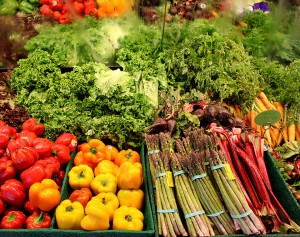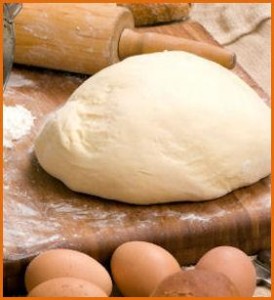
by Heidi Copeland | Apr 25, 2014

Leon County Extension’s sustainable rainwater cisterns collect rainwater from the rooftop and use the water from the cisterns to irrigate the demonstration garden.
According to the Environmental Protection Agency (EPA), the term “sustainability” has emerged as a result of significant concerns about the unintended social, environmental, and economic consequences of rapid growth. Sustainability is based on a simple principle: Everything we need for our survival and well-being depends, either directly or indirectly, on our natural environment. Therefore, sustainability creates and maintains the conditions under which humans and nature can exist in harmony, fulfilling the social, economic, and other requirements of present and future generations.
WHEW! Think about it! Sustainability is important to making sure that we have, and will continue to have, the water, materials, and resources to protect our health and our environment.
Think about it! Water, for instance. Though we might see water as an abundant resource in Florida, water is emerging as a sustainability issue sparking debate and illustrating the differences in opinions of various water users in Florida. Consider these facts:
- Heavy demand: High levels of commercial, real estate, and agricultural development have caused withdrawals to increase over time, putting pressure on natural resources.
- Changes in water use: Agricultural production and public supply are the largest users of freshwater resources in Florida. Large demands occur in municipal water supply systems as a result of landscape irrigation of lawns and golf courses.
- Environmental consequences: Depletion of groundwater resources can have negative environmental consequences, such as saltwater intrusion into freshwater resources and sinkhole development.
- Water use strategies: Strategies to balance water use include reducing the overall demand for water (through such means as increased water prices or restrictions) or increasing the supply of water (through such means as desalination of seawater).
- Water quality: Recent EPA nutrient requirements designed to protect water quality.
Just think about it! Just like there are many levels of sustainability, each and every one of us can draw from advances in science and technology to protect not only our health but the environment.
Just think about it! And then take action. The EPA website has data specific to your area of interest. Information on air, water, land, community, health, and energy can be visualized on a map, downloaded, and printed.
Think about it! Individuals can make a difference! A journey of a thousand miles begins with a single step. Each of us can promote practices to strengthen our natural environment and quality of life, ultimately improving the quality of life for everyone.
Sources: http://www.epa.gov/
UF/IFAS FCS 7242 Understanding Sustainability: The Importance of Sustainable Development and Comprehensive Plans—Goals, Objectives, Policies
UF/IFAS WC151 Water Issues in Florida: How Extension Can Facilitate Stakeholder Engagement and Involvement
by Heidi Copeland | Mar 3, 2014

Handle food safely and stay informed about food recalls.
Have you paid attention to any of the recent food recalls? In February 2014, both the U.S. Food and Drug Administration (FDA) and the U. S. Department of Agriculture (USDA) issued consumer food recalls and alerts for a variety of food safety reasons. Product recalls warned consumers about undeclared allergens, false or misleading labeling, pathogenic contamination, and unsanitary processing conditions, to name only a few of the reasons.
A safe food supply is important to everyone! Both the USDA and the FDA have responsibility for protecting different segments of the food supply however; there are other food safety agencies involved. Consumers play an important part in keeping food safe. In addition, to handling food safely, consumers need to be aware of food recalls. Watch for food recall notices in the news, at your local grocery store, and online at www.recalls.gov. If identifying marks on the food product you have purchased match the detailed information in the recall notices, then you can do the following:
- Return the product to the place of purchase for a refund. OR Dispose of the product following the instructions provided in the recall notice to assure it will not be consumed by anyone.
- Do not eat the product.
- Dispose of the product carefully.
- Do not give the product to others (do not give to food bank, your pet, for example).
- Do not puncture or otherwise open cans.
- Wash hands with warm water and soap for at least 20 seconds after handling the product.
The Bottom Line is… if you sense there’s a problem with any food product, don’t consume it. “When in doubt, throw it out!”
Share this educational information with family, friends, and neighbors. Stay informed, stay safe; check for product recalls.
View the following UF/IFAS Extension publications for more information about food regulation”
http://edis.ifas.ufl.edu/pdffiles/FS/FS12100.pdf
http://edis.ifas.ufl.edu/pdffiles/FS/FS11800.pdf
by Heidi Copeland | May 15, 2013
 One of the most comforting memories of childhood has to be the smell of homemade yeast bread wafting throughout the house! Baking yeast bread, like many other kitchen traditions is making a comeback. Bread is a wonderful source of carbohydrades, especially if the flour is made from whole grains. (These kernels consist of three parts: the bran, the embryo and the endosperm). Eating breads made with whole grain flour can help you Make Half Your Grains Whole, as the dietary guidelines recommend.
One of the most comforting memories of childhood has to be the smell of homemade yeast bread wafting throughout the house! Baking yeast bread, like many other kitchen traditions is making a comeback. Bread is a wonderful source of carbohydrades, especially if the flour is made from whole grains. (These kernels consist of three parts: the bran, the embryo and the endosperm). Eating breads made with whole grain flour can help you Make Half Your Grains Whole, as the dietary guidelines recommend.
However, the traditional yeast bread making method – proof yeast, knead dough, rise, punch down, rest, form, rise again, and bake….is being debunked!
I’ve been experimenting with many of the recipes in Artisan Bread in Five Minutes a Day and Healthy Bread in Five Minutes a Day mostly to find a simple experience for baking yeast breads with children during 4-H summer camps. However, my experiments have been so successful that I have asked permission from Publicity @St. Martin’s Press to actually publish the master recipe as long as I give credit where credit is due.
There are those out there, myself included, that swear by the discovery of Jeff Hertzberg, M.D., and Zoë Francois that Artisan Bread can indeed be made in just five minutes of “active effort” every day.
The aforementioned authors published their first book in 2007. Currently, they have three best-selling cookbooks on the market, all of which are a very practical guide to producing delicious artisan bread and bread products that require a minimal of basic ingredients: flour, water, yeast and salt. The equipment is nominal too: measuring cups and spoons, a large storage container with a lid, a sturdy mixing tool and of course sheets or pans and an oven to bake your bread in. Of course there are other gadgets but none as necessary as what is listed.
Specifically, the authors choose the French boule (“boule” in French means “ball”) as the basic model for bread making as the shape is easy to form, the taste delicious and quite nutritious.
If you are interested in giving this process a try you can find the recipe in its entirety by clicking here Master Bread Recipe.
by Heidi Copeland | May 9, 2013

Make half your grains whole with homemade whole grain bread.
One of the most comforting memories of childhood has to be the smell of homemade yeast bread wafting throughout the house! Baking yeast bread, like many other kitchen traditions is making a comeback. Bread is a wonderful source of carbohydrades, especially if the flour is made from whole grains. (These kernels consist of three parts: the bran, the embryo and the endosperm). Eating breads made with whole grain flour can help you Make Half Your Grains Whole, as the dietary guidelines recommend.
However, the traditional yeast bread making method – proof yeast, knead dough, rise, punch down, rest, form, rise again, and bake….is being debunked!
I’ve been experimenting with many of the recipes in Artisan Bread in Five Minutes a Day and Healthy Bread in Five Minutes a Day mostly to find a simple experience for baking yeast breads with children during 4-H summer camps. However, my experiments have been so successful that I have asked permission from Publicity @St. Martin’s Press to actually publish the master recipe as long as I give credit where credit is due.
There are those out there, myself included, that swear by the discovery of Jeff Hertzberg, M.D., and Zoë Francois that Artisan Bread can indeed be made in just five minutes of “active effort” every day.
The aforementioned authors published their first book in 2007. Currently, they have three best-selling cookbooks on the market, all of which are a very practical guide to producing delicious artisan bread and bread products that require a minimal of basic ingredients: flour, water, yeast and salt. The equipment is nominal too: measuring cups and spoons, a large storage container with a lid, a sturdy mixing tool and of course sheets or pans and an oven to bake your bread in. Of course there are other gadgets but none as necessary as what is listed.
Specifically, the authors choose the French boule (“boule” in French means “ball”) as the basic model for bread making as the shape is easy to form, the taste delicious and quite nutritious.
If you are interested in giving this process a try you can find the recipe in its entirety by clicking here Master Bread Recipe.pdf
by Heidi Copeland | Apr 17, 2013

Two-thirds of American household waste is due to food spoilage
Sustainability – 1. The ability to be sustained, supported, upheld, or confirmed. 2. Environmental Science: The quality of not being harmful to the environment or depleting it.
This Earth Day, think about the dictionary definitions of sustainability, especially as they relate to consumer choices. Take food, for instance. As a nation, not only are we becoming super-sized but so is our food-related waste. In August 2012, the Natural Resources Defense Council (NRDC) reported that Americans are throwing away 40 percent of their food supply in the U.S. every year. The reasons for this problem are multifaceted. Nevertheless, consumers are a major contributor to the problem. Key findings include:
- The average American family of four ends up throwing away an equivalent of up to $2,275 annually in food (I’ve started to tally up my own family waste and believe me, it adds up! Leftovers not eaten in time, half a can of evaporated milk, brown lettuce, wilted carrots, yellowing broccoli, etc…)
- In average American households, two-thirds of household waste is due to food spoilage
- 40 percent of fresh fish
- 23 percent of eggs
- 20 percent of milk
- Citrus fruits and cherries top the list for fruits, and sweet potatoes, onions, and greens are commonly wasted vegetables
- Much of household waste is due to over purchasing, food spoilage, and plate waste.
- One-third is caused by people cooking or serving too much (Package size, serving size, and dishware size all influence how much each of us eats).
Wasted food also translates into wasted natural resources because of the energy, water, and farmland necessary to grow, transport, and store food. Additionally, food waste is the single largest component of solid waste in U.S. landfills.
Every one of us can be a facet in solving this increasing problem. Each person can waste less food by:
- shopping wisely
- knowing when/how food goes bad
- eating produce that is perfectly edible even if it’s less cosmetically attractive (much of this is thrown out)
- cooking only the amount of food you can reasonably eat
- eating leftovers (consider them a bonus for lunch tomorrow)
Norman Vincent Peale says, Change your thoughts and you change your world. Can the same thinking apply to our behavior? If each and every one of us made a small behavior change, it could help change the world.
For more information: http://www.nrdc.org/food/wasted-food.asp
http://www.nrdc.org/living/eatingwell/saving-leftovers-saves-money-resources.asp





